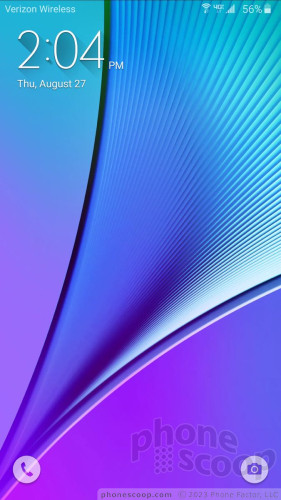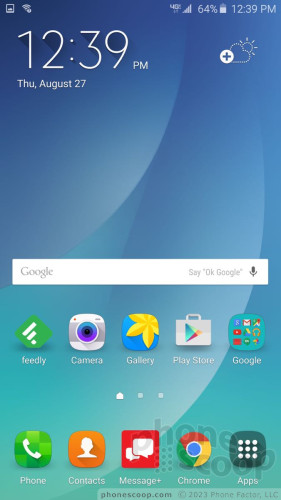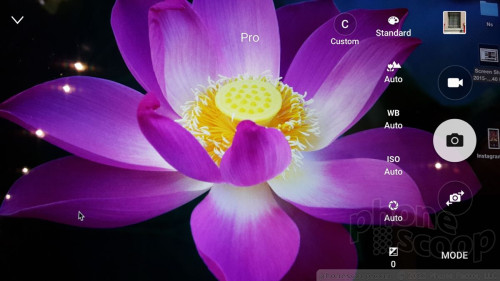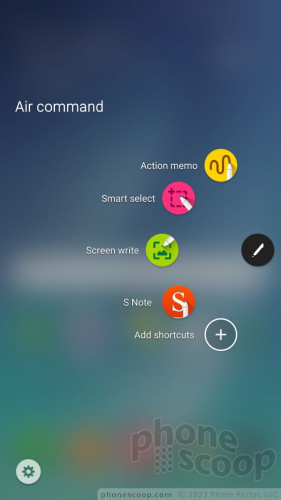Review: Samsung Galaxy Note 5 for Verizon Wireless
Aug 27, 2015, 5:30 PM by Eric M. Zeman

Samsung's top-of-the-line smartphone impresses with its classy design and blistering performance. The Galaxy Note 5 is a compelling Android device with its big screen, fast processor, and capable camera. Here is Phone Scoop's full report.
Hardware
Is It Your Type?
The Samsung Galaxy Note, now in its fifth generation, is the quintessential big-screened Android phone. If you want a large, powerful, classy handset that comes with a stylus, the Note 5 is the only one to get.
Body
If you were surprised by the Note 5 when Samsung unveiled it in August, then you haven't been paying attention. The Note 5 adopts the design language seen on the Galaxy S6 earlier this year, which simply makes the Note 5 more of a good thing.

The Note 5 is an ultra-premium handset. The design features a metal frame sandwiched between two glass panels. The materials and build quality are second-to-none. I appreciate the attention to detail that's evident in the shape of the aluminum sides as well as the curves of the glass. The seams are fitted together flawlessly. The Note 5 exudes style and class in every way, and will be a fine companion if you're dressed up for a night on the town.
Of course, it's darned big. The Note 5's dimensions are nearly identical to those of the iPhone 6 Plus. It says something that Samsung could give the Note 5 a bigger screen (5.7 inches) than the iPhone 6 Plus, yet design a fractionally shorter and narrower phone. The Note 5 is only slightly more compact than last year's Note 4. The glass and metal mean it's a weighty handset, but it could be a lot worse. Glass is more breakable than the old plastic covers, but I'd rather take my chances with the glass than suffer through another faux-leather rear shell.
Given its size, Samsung did as well as it could to make the phone comfortable to hold and use. The rear glass panel is curved generously right where it meets the side of the phone. This helps offset the size a little bit where it joins the flesh of your palm. The entire phone is slippery as hell; the finish on the Gorilla Glass 4 panels is smooth, which means the phone will easily slip into — and out of — your pockets.
Some people may worry enough about the glass to protect it with a case. Adding a case will hide the phone's pleasing design and make the phone larger.
The front of the phone carries forward design traits we've seen on Samsung phones for years. The panel is mostly display with thin side bezels and thicker top and bottom bezels to house the usual set of components. Above the screen, for example, are two sensors, the chrome-accented speaker grille, and the user-facing camera. Below the screen, you'll see the oblong home screen button / fingerprint reader, which is flanked by capacitive multi-tasking and back keys. The home button has a chrome rim, which helps it stand out visually, and the physical profile is excellent. I found the button easy to find and use.

The volume buttons are on the left. They are two separate keys, rather than a single toggle. They have excellent profiles, travel, and feedback. The screen lock button, on the right, has similarly pleasing characteristics. I do wish the Note 5 had a dedicated camera button, especially since there's plenty of room for it.
The SIM card tray is on the top edge. The bottom edge holds the stereo headphone jack, the micro USB port, the grill for the speakerphone, and the stylus. There's no IR port, unlike last year's phone.
On the Note 5, the exposed end of the S Pen (stylus) is flush with the flat bottom edge of the phone. Press it in, and the stylus' top end will pop out. You then pull the top end to retrieve the stylus from the handset's chassis. It's not as easy to remove as the stylus on previous Note devices, but it works well enough. The stylus itself is decent. It's thin and light, and the action button is a cinch to find and use. Of course, we've learned not to insert the pen backwards. Thanks to the design, it can become stuck and damage the sensor that detects whether or not the stylus is installed. Make sure you put the pointy end in!
The camera module protrudes noticeably from the rear panel. It has not one, but two (!) chrome accents, which, oddly, draw attention to the camera bump and its size. The flash and heart rate sensor are packaged together in a separate module to the right of the camera, but they are flush with the surface.

Many Samsung fans were not happy with the company's decision to dump removable rear covers, swappable batteries, and swappable memory cards on the Galaxy S6. Unfortunately, Samsung made the same decision (mistake?) with the Note 5. The battery is sealed in tight, and there's no memory card slot. To help offset that loss a bit, the Note 5 is compatible with most wireless charging pads thanks to support for multiple wireless charging standards. What's more, it includes rapid charging and rapid wireless charging, with the proper (Samsung) pad.
The Note 5 is an incredible piece of hardware, despite its shortcomings, and stands near the top of the big-screened smartphone mountain.
Screen
What's not to love about a 5.7-inch quad-HD display? Damn, the Note 5's screen kicks butt. It's amazing in every way. Samsung uses Super AMOLED tech for its screens (as opposed to LCD), and the Note 5's display is a winner across the board. It's pixel-rich, bright, colorful, contrasty, and flat-out incredible. I was able to use it indoors and out with no problem, and viewing angles are impressive. I saw minimal brightness drop when the phone was tilted side to side, and colors remained accurate. Quite honestly, the Note 5's screen is the best available on a smartphone right now. Yes, it's that good.
Signal
I tested the Note 5 on Verizon Wireless' network in and around New York City. The phone did a good job connecting to Big Red's ever-present signal. Most times the phone showed several bars of 4G LTE coverage and never dropped to 3G or worse, even in weak signal areas. Importantly, I was able to connect calls no matter how strong or weak the signal, and the phone didn't drop or miss any calls while I reviewed it. Data speeds across Verizon's LTE service were solid. I was never disappointed with web page load times, nor app downloads, nor Facebook refresh rates.
Sound
I was not particularly impressed with the Note 5 as a voice phone. Even with the "extra volume" setting enabled, the Note 5 is just barely loud enough with everything at the maximum level. Louder environments, like busy city streets, made it rather difficult to hear calls. Holding conversations in moving cars was difficult. Quality was also somewhat lacking. Voices sounded muffled through the earpiece, as though people were speaking through a wall. Calls were never "loud and clear."
Switching to the speakerphone didn't solve these problems. The speakerphone was also feeble in terms of raw power and delivered the same stuffy call quality. It's usable, but only in quiet environments.
Ringtones and alerts were able to get my attention the majority of the time. The vibrate alert delivered a satisfying jolt when inbound messages arrived.
Whether you use Google's Play Music app, Samsung's Milk Music app, or the stand-alone MP3 player, music sounds good when pumped through the Note 5's stereo headphone jack. I have no complaints on that front.
Battery
The Note 5's glassy design necessitated the sealed-in battery. Some may be further disappointed to learn the Note 5's 3,000 mAh power source is 220 mAh smaller than last year's Note 4. In my experience with the phone, it was able to provide a bit more than a full waking day of power consistently, but I was hoping for better. It never delivered 36 - 48 hours of uptime. The iPhone 6 Plus, in comparison, easily outlasts the Note 5. But the Note 5 does surpass the Galaxy S6 with flying colors. Bottom line: big phones should have big batteries that provide at least a day and a half of usable power. The Note 5 doesn't deliver on that front, although it should get people through a single day.
Samsung sort of makes up for the power-hungry nature of the phone with rapid charging and rapid wireless charging. I tested the rapid charging via USB and found the 3,000 mAh battery could ramp up from 0% charge to 100% charge in just under two hours. That's pretty quick. Of course, the more you charge it, the sooner the battery will lose its ability to hold a charge.
The Note 5 also includes Samsung's Power Saver and Ultra Power Saver modes. These do make a difference if you run into trouble. The first option tones down a few features and doesn't crimp the phone's performance too much. For example, it will limit the CPU a bit, turn down brightness, turn off the key backlights, and put the display to sleep faster. The second takes a more aggressive approach and kills off all but the basics. It strips the UI down to the bare essentials, goes grey-scale, and prioritizes only key functions, such as calling and messaging. These will definitely help you save power in a pinch.
Bluetooth, GPS, NFC, WiFi
I was very pleased with the Note 5's wireless performance all around. The Bluetooth radio did a great job as far as pairing with other devices was concerned. Call quality was not the best, especially via my car's hands-free system. I'd call the experience noisy. Music pushed to aptX-compatible Bluetooth headsets sounded fantastic.
The GPS, NFC, and WiFi radios all functioned perfectly, I didn't have any problems with them. I was impressed with the speed of the GPS radio, which pinpointed me to within 10 feet in just a couple of seconds on a consistent basis. The NFC radio allowed me to quickly pair the phone with other hardware and the WiFI radio was speedy for use in browsing the web.
Software
Lock Screen
There are no fancy gestures, motions, or taps to wake the Note 5's screen; you have to press the lock screen button on the side of the phone to wake it up. With the lock screen lit, you can see the big digital clock up top with notifications beneath. Along the bottom are two shortcuts: one to the phone and one to the camera. The camera shortcut is a bit redundant, since a double-tap of the home button also launches the camera (even when the Note 5 is locked).

You can choose a PIN, password, pattern, or fingerprint to unlock the phone, and you can customize how much content is revealed by notifications on the lock screen, as well as what animation is used to unlock the phone.
Bottom line: it suffices, but doesn't necessarily do anything unique.
Home Screen
The Note 5 uses Android 5.1 “Lollipop” as the underlying operating system with Samsung's TouchWiz user interface on top. Samsung has committed to updating the Note 5 to Android 6.0 “Marshmallow” at some point down the road.

The home screen panels, main app drawer, notification shade, and settings tools are identical to those of the GS6 and are straightforward to figure out and use. Like the Galaxy S6 and S6 Edge, the Note 5 offers users an incredible amount of flexibility when it comes to personalizing the experience. In addition to the usual spate of wallpapers, alerts, ringers, and widgets, the Note 5 lets users set fonts, text sizes, and choose the maximum number of widgets that can appear on the home screen panels.
Themes are the biggest addition to TouchWiz and they can be a lot of fun. Many of them completely alter the home screen experience of the handset with different icons, color palettes, and fonts. Three are preloaded, but dozens are available for download.
The Note series pioneered split-screen multitasking on Android, so naturally the Note 5 supports it. This allows two apps to function in separate windows at the same time. It's fairly easy to activate, and a decent number of apps work with the feature, such as the browser, Gmail, YouTube, messaging, and so on. It's a cinch to drag content from one live window to another and otherwise interact with the multiple windows.
The Note 5 offers Samsung's Easy Mode, which totally dumbs down the home screens and menus to a more digestible format. I expect most Note owners are power users and will ignore Easy Mode, but those with poor vision might find Easy Mode is easier on the eyes.
The heart of the Note 5 beats with the power of eight 2.1 GHz cores with a 4GB circulatory system (RAM). The Exynos processor is incredibly fast and I can say with all sincerity that the Note 5 is among the fastest phones I've used.
Camera
Samsung snatched the camera app from the GS6 and dropped it into the Note 5. As noted earlier, there's no dedicated camera button, but you can launch the camera with two quick presses of the home button. It pops open in a jiff.

The camera UI is much improved when compared to previous generations, but there's still a lot going on. Icons are floating all over the place and it takes a minute or two to acclimate to the arrangement of buttons, toggles, and switches.
Here are the basics: touch the screen anywhere to focus. Press and hold to set exposure. A quick tap of the shutter button captures a single image. Press and hold to fire off a burst of shots. Separate camera and video buttons allow you to snap shots while recording video. Want to adjust the settings? You have control over aspect ratio, image size, location data, color, and so on.
Beyond the basics, the Note 5 includes an assortment of shooting modes. Where Samsung gave the GS6 seven shooting modes, the Note 5 has nine: auto, pro, bokeh, panorama, video collage, live broadcast, slow motion, fast motion (time-lapse), and virtual shot. You can download more shooting modes from Samsung if you want.
The pro mode is impressive in that it gives users control over nearly every facet of the camera's behavior. It's truly powerful for the knowledgeable user. The virtual tour mode, which we found to be weird on the GS6, was equally weird on the Note 5. It's probably best ignored unless you're trying to give someone an in-depth look at a 3D object. The other shooting modes behave as they do on most handsets.
The single most interesting feature, Live Broadcast, lets you push video live to your YouTube account. This feature worked flawlessly when I tested it. You have to jump through some hoops first (agree to data usage jargon, sign into YouTube, etc.), but otherwise it's point-and-share live video straight from your phone to YouTube. The function then saves the live video into your YouTube channel for regular playback. Samsung isn't the first to offer this feature, but it worked really well from the camera app.
The user-facing camera includes several shooting modes, too. The most helpful is the wide-angle selfie, which lets you squeeze more people into the frame.
The Note 5's camera does everything in an instant, which I often find is vital (hey, I have kids).
Photos/Video
Like the GS6, the Note 5 has a 16-megapixel sensor with an aperture of f/1.9 to let in more light. I am extremely happy with the results it produces. Focus, exposure, and white balance were almost always perfect, even in contrast-y places that might confuse lesser cameras. I didn't see any grain. Colors look exceptional. The Note 5 can handle the majority of your basic photography needs.
The selfie cam, which has a 5-megapixel sensor, is also excellent. I did see a bit more grain than with the main camera, but that's to be expected. The wide-angle option is truly useful for group shots, which for the most part turned out well. Colors, exposure, and focus were generally right on. If you love taking pix of yourself, the Note 5 is a fine selfie-snapping smartphone.
The video camera can capture video up to 4K, but you needn't bother. For starters, with no memory card slot you'll eat up your precious storage. Moreover, with no SuperSpeed USB, transferring the videos off the phone would be a pain. The full HD video you record will probably suffice for most of your videography needs.
The results exceeded my expectations. Video is crisp, colorful, and shows proper lighting. As with the camera, the Note 5 should cover almost all of your video needs.
Verizon and Samsung Bloat
Verizon crammed the Note 5 with bloatware. Really, there are an insane number of Verizon-branded apps installed on this thing. Verizon also pushed the usual selection of Amazon-branded apps onto the Note 5. I'm happy to report, however, that Verizon will allow you to remove about half of the junk apps. Most importantly, you can ditch several games that take up huge amounts of storage.
Believe it or not, Samsung-branded apps are largely absent. The Note 5 has Milk Music, but not Milk Video. It has S Note, S Health, and S Voice, but not Samsung's messaging app, nor its Galaxy App Store.
It's worth pointing out that the Note 5 comes with either 32GB or 64GB of storage. Samsung is not (yet) offering a 128GB version of the phone. The 32GB model, which we tested, leaves about 24GB available to end users.
One of the more significant new Samsung apps is SideSync 4.0, which lets the Note 5 connect wirelessly to PCs for sharing files, responding to text messages, or answering calls. The companion Mac OS app is not yet available so we were unable to test this feature.
S Pen
Samsung didn't do too much to expand the S Pen's powers this year. When the stylus is removed, the Air Command button appears on the home screen and stays there until the stylus is put away. This lets you quickly tap into the S Pen's features, which appear in a semi-circle when you touch the stylus to the Air Command button. I like that the Note 5 allows users to customize the tools that show up in Air Command.

The toolset includes action memo, smart select, screen write, and S Note. Action memo is a basic note-taking app. Smart select lets you capture text, photos, and hyperlinks from web sites. Screen write takes a screenshot and lets you annotate it. S Note is the Note 5's more fully featured note-taking app and can be used to manage all the action memos and smart select content you've created. These are all fine tools that work well, even if they are a bit redundant.
Wrap-up
The Note 5 is one of those phones that puts its money where its mouth is; it delivers the goods. Samsung did a great job in designing and building a high-end smartphone that performs well in nearly every way.
The hardware is fantastic, the display is incredible, the wireless performance is top-notch, and the battery life is good enough. I'd prefer if Samsung meddled less with the Android software, but it's nice that you can take control of the home screen experience via themes and other customization tools. I was pleased with the camera, which delivers consistently good results. The S Pen software adds some functionality that few other phones have. Everything on the phone runs quickly and smoothly. My most serious complaint about the Note 5 is the so-so call quality (but who talks on their phones anymore?) Some may be put off by the lack of removable battery and memory card, although these limitations don't bother me, personally.
If you want the best phablet you can buy, the Galaxy Note 5 should be at the top of your shopping list.

Comments
Will never buy Note 5 (or Galaxy S6) lineup w/o removable battery & SdCard slot
(continues)
Similar results with AT&T
I don't remember what ...
(continues)
















































































 Review: Samsung Galaxy Note 5 for Sprint
Review: Samsung Galaxy Note 5 for Sprint
 Hands On with the Samsung Galaxy Note 5 and S6 Edge+
Hands On with the Samsung Galaxy Note 5 and S6 Edge+
 Samsung Galaxy Note 5 and S6 Edge+ Earn Updates from Verizon
Samsung Galaxy Note 5 and S6 Edge+ Earn Updates from Verizon
 Verizon Delivering Marshmallow to Galaxy Note 5
Verizon Delivering Marshmallow to Galaxy Note 5
 Samsung Pay Launches In the US
Samsung Pay Launches In the US
 Samsung Galaxy Note5 (CDMA)
Samsung Galaxy Note5 (CDMA)




